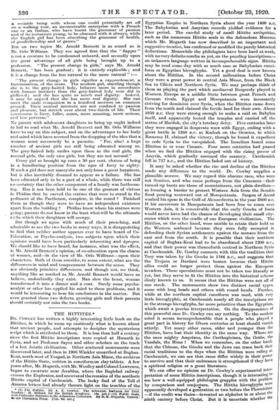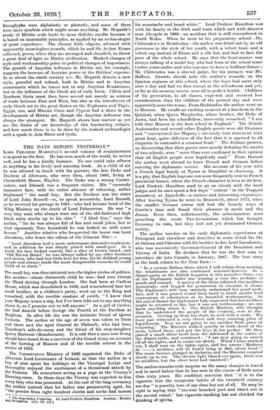THE HI1 11 ES.*
Die. COWLEY has written a highly interesting little book on the Hittites, in which he sums up cautiously what is known about that ancient people, and attempts to decipher the mysterious script which is attributed to them. It is less than half a century since the first Hittite inscriptions were copied at Hamath in Syria, and set Professor Sayce and other scholars on the track of a lost Asiatic civilization. Other scattered monuments were discovered later, and then in 1906 Winkler unearthed at Boghaz- Keui, north-west of Yozgad, in Northern Asia Minor. the archives of the Hittite State, written in cuneiform on claytableta. A few years after, Mr. Hogarth, with Mr. Woolley and Colonel Lawrence, began to excavate near Jerablus, where the Baghdad railway crosses the Euphrates, and uncovered theremains of the southern Hittite capital of Carchemish. The lucky find of the Tell el A/name letters had already thrown light on the troubles of the • (I) The Mattes. By A. E. Cowley. The Schweich Lectures for 1918. London: H. Milford, for the British Academy. ins. net.)—(2) HOS. Seale. leuh Particular Refereuee to the A elinaolean Colledurn. By D. G. Hogarth. Oxford: the Clarendon Press. Mis. 6d. net.] Egyptian Empire in Northern Syria about the year 1400 ram The Babylonian and Assyrian records yielded evidence for a later period. The careful study of small Hittite antiquities, such as the numerous Hittite seals in the Ashmolean Museum which Mr. Hogarth has now described in an important and suggestive treatise, has confirmed or modified the purely historical deductions. Meanwhile the philologists have been hard at work, with no very definite results as yet, on the puzzling inscriptions— an unknown language written in incomprehensible signs. Hittite may be read sonic day with as much case as Babylonian cunei- form or Egyptian hieroglyphs. Yet a good deal is now known about the Hittites. In the second millennium before Christ
they were a great power in central Asia Minor, from the Black Sea to Cilicia and Northern Syria. We may perhaps think of them as playing the part which mediaeval Burgundy played in Western Europe as a middle State between great French and German rivals. Egypt and Mesopotamia were incessantly striving for dominion over Syria, when the Hittites came down
from the north and claimed the fertile land for their own. About 1950 B.C. they were strong enough to make a raid on Babylon
itself, and apparently looted the temples and carried off the statue of Marduk, the city's tutelary deity. Five centuries later they were engaged in desperate wars with Egypt, ending with a
great battle in 1280 B.e. at ICadesh on the Orontes, in which
Rameses II. claimed the victory, though he found it expedient to cede Syria to the vanquished. The Israelites found some Hittites in or near Canaan. Four more centuries had passed when we find the Hittites engaged with the rising power of Assyria, which gradually assumed the mastery. Carchemish fell in 717 lac., and the Hittites faded out of history.
It may be asked whether the rise and decline of the Hittites made any difference to the world. Dr. Cowley supplies a plausible answer. We may regard this obscure race, who were not Semites, and who came perhaps from the Caucasus—their turned-up boots are those of mountaineers, not plain-dwellers-
as forming a barrier to protect Western Asia from the Semitic flood pouring westward out of Mesopotamia. Sargon of Accad washed his spear in the Gulf of Alexandretta in the year 3800 B.C.
If his successors in Meeopotamia had been free to roam over Western Asia, it is conceivable that the early Greeks of Ionia would never have had the chance of developing their small city- states which were the cradle of our European civilization. The Hittites, on the other hand, were unable to retain their hold on the Western seaboard because they were fully occupied in defending their Syrian settlements against the menace from the
Cant and from the south. It is possible that their northern capital of Boghaz-Keui had to be abandoned about 1200 n.e., and that their power was thenceforth centred in Northern Syria at Carchemish. Dr. Cowley connects with this the tradition that Troy was taken by the Greeks in 1184 B.C., and suggests that
the Trojans or Dardani were beaten because their Hittite
allies could no longer protect them against the European invaders. These speculations must not be taken too literally as
yet, but they serve to fit the Hittites into the historical scheme dimly known to us. It seems that the Hittites were not all of one stock. The monuments show two distinct racial types, some with long heads and others with round heads. Further, while at the northern capital cuneiform was used, with very little hieroglyphic, at Carchemish nearly all the inscriptions are
in the strange hieroglyphs, far more primitive than the Egyptian, which await a precise interpretation. On the disappearance of this powerful race De. Cowley can say nothing. To the modern mind it seems incomprehensible that a people who played a great part in history for fifteen centuries at least should vanish utterly. Yet many other races, older and younger than the Hittites, have lost their identity in the same way. Where are the once mighty Assyrians, the Carthaginians, the Goths, the Vandals, the Huns 1 When we remember, on the other hand, that the Chinese, the Greeks and the Jews can trace back their racial traditions to the days when the Hittites were ruling at Carchemish, we can see that races differ widely in their power to survive and that their endurance is strengthened if they be" a spiritual religion or a great literature.
We can offer no opinion on Dr. Cowley's experimental inter" pretation of some Hittite inscriptions, though it is interesting to see how a well-equipped philologist grapples with the problem by comparison and conjeclure. The Hittite hieroglyphs were apparently developed a generation or two before the Phoeniciso —if the credit was theirs—invented an alphabet in or about the ninth century before Christ, But it is uncertain whether the hieroglyphs were alphabetic or phonetic, and some of thom were mere symbols which might mean anything. Mr. Hogarth's study of Hittite seals leads to more definite results because it is based on immutable principles, as applied by an archaeologist of great experience. The clumsy little objects, adorned with apparently meaningless scrawls, which he and Sir Arthur Evans collected, prove, when they are arranged and classified, to throw a great deal of light on Hittite civilization. Marked changes of style and workmanship point to political changes of importance. The growth of Assyrian influence in Hittite art, for example, suggests the increase of Assyrian power at the Hittites' expense. In or about the ninth century B.c. Mr. Hogarth detects a new style, graceful and refined, both in Hittite and in Assyrian monuments which he traces not to any Assyrian Renascence, but to the influence of the Greek art of early Ionia. Mids. and Northern Syria must then have served not merely as centres of trade between East and West, but also as the introducers of early Greek art to the great States on the Euphrates and Tigris. Egypt, too, and Minoan Crete and Cyprus had a share in the development of Hittite art, though the Assyrian influence was always the strongest. Mr. Hogarth shows how narrow as yet aro the limits of our knowledge of this fascinating subject, and how much there is to be done by the trained archaeologist with a spade in Asia Minor and Syria.



































 Previous page
Previous page